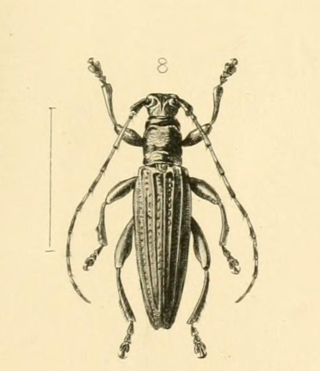Related Research Articles

The Tasman Sea is a marginal sea of the South Pacific Ocean, situated between Australia and New Zealand. It measures about 2,000 km (1,200 mi) across and about 2,800 km (1,700 mi) from north to south. The sea was named after the Dutch explorer Abel Janszoon Tasman, who in 1642 was the first known person to cross it. British explorer Lieutenant James Cook later extensively navigated the Tasman Sea in the 1770s during his three voyages of exploration.

Lord Howe Island is an irregularly crescent-shaped volcanic remnant in the Tasman Sea between Australia and New Zealand, part of the Australian state of New South Wales. It lies 600 km (320 nmi) directly east of mainland Port Macquarie, 780 km (420 nmi) northeast of Sydney, and about 900 km (490 nmi) southwest of Norfolk Island. It is about 10 km (6.2 mi) long and between 0.3 and 2.0 km wide with an area of 14.55 km2, though just 3.98 km2 of that comprise the low-lying developed part of the island.

Lord Howe Island Airport is an airport providing air transportation to Lord Howe Island. Lord Howe Island is located in the Tasman Sea, 600 km (370 mi) east of Port Macquarie on the coast of mainland Australia. The airport is operated by the Lord Howe Island Board.

The Lord Howe flax snail or the Lord Howe placostylus, scientific name Placostylus bivaricosus, is a species of large air-breathing land snail, a terrestrial pulmonate gastropod mollusc in the family Bothriembryontidae.

The Lord Howe long-eared bat was a vespertilionid bat known only by a single specimen, a skull found on Lord Howe Island in 1972. A mammalian insectivorous species resembling the long-eared Nyctophilus, with an elongated head that is comparatively larger, about which almost nothing is known. The bat may have been casually observed in flight during the twentieth century, but is likely to have become extinct since the island's discovery and occupation. The demise of N. howensis is possibly the result of shipwrecked rats and the owls introduced to control them.

Xylotoles is a genus of beetle in the family Cerambycidae. It contains several species, including Xylotoles costatus, once thought extinct. The longhorn beetles belonging to genus Xylotoles is classified as Endangered (EN) on the IUCN Red List.

The Lord Howe boobook, also known as the Lord Howe morepork, was a bird in the true owl family endemic to Lord Howe Island in the Tasman Sea, part of New South Wales, Australia. It is an extinct and little-known subspecies of the morepork.

Arthur Sidney Olliff, was an Australian taxonomist who was active as Government entomologist in New South Wales. He came to Australia in December 1844 to work at the Australian Museum.

Erskine Valley is a small, steep-sided, forested valley, containing the perennial Erskine Creek with several small waterfalls. About one kilometre long and broad, it lies between Mounts Lidgbird and Gower, on the western side of the southern end of Australia’s subtropical Lord Howe Island in the Tasman Sea. The valley is traversed by the popular hiking track to the summit of Mount Gower. It was named after Thomas Erskine, Lord Chancellor of the United Kingdom from 1806 to 1807.

Arthur Francis Basset Hull (1862–1945) was an Australian public servant, naturalist and philatelist. He signed the Roll of Distinguished Philatelists in 1921.
Xylotoles pattesoni is a species of beetle in the family Cerambycidae. It was described by Olliff in 1888. It is known from Australia and New Zealand.
Xylotoles selwini is a species of beetle in the family Cerambycidae that was described by Olliff in 1888. It occurs in Australia.
Somatidia capillosa is a species of beetle in the family Cerambycidae. It was described by Arthur Sidney Olliff in 1889. It is known from Australia, from Lord Howe Island.

Drepanacra binocula, known as the Australian variable lacewing, is a species of brown lacewing in the family Hemerobiidae, found across Australia and New Zealand, including Lord Howe Island, Norfolk Island and the Kermadec Islands.
Pseudocharopa is a genus of three species of pinwheel snails that are endemic to Australia's Lord Howe Island in the Tasman Sea.

Pseudocharopa ledgbirdi, also known as the Mount Lidgbird pinwheel snail or the Mount Lidgbird charopid snail, is a species of pinwheel snail that is endemic to Australia's Lord Howe Island in the Tasman Sea.

Pseudocharopa whiteleggei, also known as Whitelegge's pinwheel snail or Whitelegge's land snail, is a species of pinwheel snail that is endemic to Australia's Lord Howe Island in the Tasman Sea.
Hybomorphus is a genus of weevil in the family Curculionidae. There is just one species in the genus, the type species, Hybomorphus melanosomus, the Lord Howe Island ground weevil.
Melittomma pervagum is a species of beetle in the family Lymexylidae. It was described by Arthur Sidney Olliff in 1889. It is known from Australia, from Lord Howe Island.
Rhinotia acrobeles is a species of weevil in the family Belidae. It was first described by Arthur Sidney Olliff in 1889 as Belus acrobeles, from specimens found on Lord Howe Island.
References
- 1 2 "Australian Faunal Directory: Xylotoles segrex". biodiversity.org.au. Retrieved 2021-09-08.
- ↑ A.S. Olliff (31 December 1889). "The insect fauna of Lord Howe Island". The Australian Museum Memoir. 2: 77–98. doi:10.3853/J.0067-1967.2.1889.482. ISSN 0067-1967. Wikidata Q103898587.
- ↑ BioLib.cz - Xylotoles segrex. Retrieved on 8 September 2014.